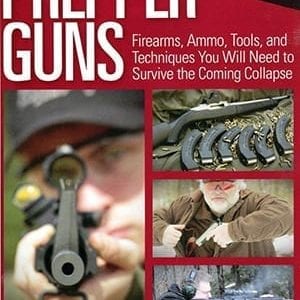Jeff Cooper founded Gunsite Academy, one of the top firearms training centers in the world. He was a prolific writer, leaving behind several books and he was also a hard core big game hunter with world wide experience.
One lasting legacy to the gun world is the continuing popularity of the Scout Rifle, which he first began to develop in 1968. He wrote about the idea in his book, The Art of The Rifle.
He said, “The scout, therefore, was a man by himself or possibly with one companion. He was not supposed to get into fights, but if he could not avoid contact, he was expected to shoot quickly, accurately, and hard. His weapon, therefore, should be somewhat more specialized than that of the line soldier.”
Cooper used a Remington Model 600 carbine to build “Scout One,” the first of a series of Scout Rifles. Cooper was also a fan of the .350 Remington Magnum in the Model 600 style rifles for hunting big game, which proves he understood terminal ballistics. He was never a fan of small for the applied use cartridges and no doubt would scoff at today’s trend in that direction.
Cooper’s Scout concept was a bolt-action carbine chambered in 30-caliber, less than one meter in length, and less than three kilograms in weight. The gun is fitted with iron sights, a forward mounted optic and a practical sling.
Cooper defined the Scout Rifle as “a general-purpose rifle that is a conveniently portable, individually operated firearm, capable of striking a single decisive blow, on a live target of up to 200 kilos in weight, at any distance at which the operator can shoot with the precision necessary to place a shot in a vital area of the target”.
The Scout Rifle concept, as it evolved over the years, was not a hard set of specifications and Cooper kept it fluid. He believed that the .308 Winchester was the cartridge of choice. Suggesting a .223 may risk the ghost of Jeff Cooper haunting your nights. He disdained the cartridge in a Scout and said, “. . . to reduce a Scout to take this cartridge is rather like putting a Volkswagen engine in a Porsche. You can do it, but why should you?”
Cooper initially thought that a ghost ring rear sight with a post front sight was fine and that optics were optional at best. He later revised that when Bushnell came out with a pistol scope that could be mounted forward on the gun. This allowed easy access to the action for top loading and kept the scope away from the shooter’s face. Today there are several outstanding rifle scopes from Leupold, Weaver and Burris. These optics have put to rest the reliability problems that plagued the early scout rifle scope sights as the quality is excellent. The forward mounted scope has come to define the “Scout Rifle” concept.
Cooper was a very smart man who developed his own ideas and didn’t follow the pack. But he was a bit old school as well. With the advancements of semi-auto rifles that can still remain true to the Scout Rifle concept in terms of performance and use, I have to wonder if he would embrace those as part of the Scout Rifle family?
But the question is moot as Cooper died in 2006, before the boom in civilian AR type rifles took off. Back when he was developing the Scout Rifle concept in the seventies and eighties, the options for civilian owned .308 battle rifles were very limited and none of the guns matched the criteria he put forth for a Scout Rifle.

Is a modern, lightweight AR-L in .308 a better “scout” rifle? With a removable magazine there is no need to mount the scope forward for clip loading.
I know that Cooper did not like the AR-15, but that was mostly because of the 5.56 cartridge. I like to think that he would embrace this new generation of lighter weight, .308 chambered semi-auto carbines, both as battle rifles and as members of the Scout Rifle family. However, with Cooper gone, that question will remain in the company of “the number of angels dancing on the head of a pin,” and just as unanswerable.
It could be argued that the Scout Rifle idea is a bit dated. However the Scout Rifle remains popular. For “crossover” use, that is a rifle used for defense as well as foraging and hunting, the Scout Rifle still makes a lot of sense. In truth, Cooper designed it for this situation with it weighted toward being a hunting gun. He recognized that the needs of a scout are different than a typical military man and that the Scout Rifle was for solving problems, not fighting battles. As for the hunting aspect, he wrote, “The best weapon for the military scout may also be the best weapon for the private citizen stalking the deer.”
If you are a bolt-action guy and are familiar with running that style of rifle fast and smooth, then the Scout Rifle may be what you need for personal and home defense. For a rifle to be used while “scouting” when you are out and about, foraging or checking the road ahead, it is a great choice. After all, that’s what it was designed for.
Those who buy a Scout Rifle are never making a mistake; if for no other reason than because each time you fire the gun, the spirit of Colonel Jeff Cooper will be watching over you and guiding the bullet to its destination.
If you want to know more about Scout Rifles, keep your eyes open for two new books. My book, Survival Guns for Preppers has an extensive section on Scout Rifles. Richard Mann is working on a book called The Scout Rifle Study. Both are scheduled to be released in the spring.








